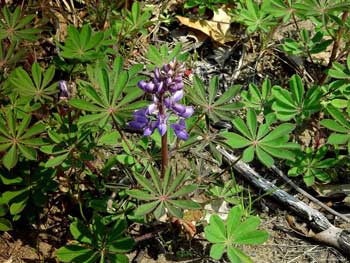Contents:
Common Names | Parts Usually Used | Plant(s) & Culture | Where Found
Legends, Myths and Stories | Uses | Warning | Resource Links | Bibliography
Scientific Names

- Lupinus perennis L.
- Pea family
Common Names
- Lupine
Parts Usually Used
Leaves
Back to Top
Description of Plant(s) and Culture
A perennial with palmately compound leaves, racemes of white, rose yellow, or blue flowers, and pods containing beanlike seeds; used for forage; green manure, etc., 1-2 foot high. Leaves long-stalked; divided into 7-11 oblong-lance-shaped segments. Flowers more often blue; pea like; in a showy raceme; April to July.
Back to Top
Where Found
Found in dry soils, open woods. New York to Florida; West Virginia; Ohio, Indiana, Illinois.
Back to Top
Legends, Myths and Stories
The name of the Wild Lupine means wild wolf. Origin of the name is unknown.
Paiute name: “Kao sigi”; Shoshone name: “Cupi chuk”; Warm Springs Indians name: “Wapeayta”. The tea of the seeds helps failure to urinate.
Back to Top
Uses
Native Americans drank cold leaf tea to treat nausea, failure to urinate, and internal hemorrhage. A fodder used to fatten horses and make them “spirited and full of fire”.
Back to Top
Warning
Seeds are Poisonous. Some lupines are toxic, others are not. Even botanists may have difficulty distinguishing between toxic and nontoxic species. Best to leave alone if inexperienced with this one.
Use only when successfully identified and under medical supervision
Back to Top
Resource Links
Forgotten Pioneer Plants: What Early Settlers Grew for Food and Medicine
Bibliography
![]() Eastern/Central Medicinal Plants
Eastern/Central Medicinal Plants, by Steven Foster and James A. Duke., Houghton Mifflin Company, 215 Park Avenue South, New York, NY 10000
![]() Indian Uses of Native Plants
Indian Uses of Native Plants, by Edith Van Allen Murphey, Meyerbooks, publisher, PO Box 427, Glenwood, Illinois 60425, copyright 1958, print 1990
![]() Webster’s New World Dictionary
Webster’s New World Dictionary, Third College Edition, Victoria Neufeldt, Editor in Chief, New World Dictionaries: A Division of Simon & Schuster, Inc., 15 Columbus Circle, New York, NY 10023
